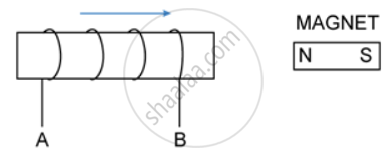Advertisements
Advertisements
Question
State Faraday's laws of electromagnetic induction.
Solution
Faraday's laws of electromagnetic induction:
- First law: Whenever there is a change of magnetic flux in a closed circuit, an induced emf is produced in the circuit. This law is a qualitative law as it only indicates the characteristics of induced emf.
- Second law: The magnitude of induced emf produced in the circuit is directly proportional to the rate of change of magnetic flux linked with the circuit. This law is known as quantitative law as it gives the magnitude of induced emf.
APPEARS IN
RELATED QUESTIONS
In the following diagram an arrow shows the motion of the coil towards the bar magnet.
(1) State in which direction the current flows, A to B or B to A?
(2) Name the law used to come to the conclusion.

- How would you demonstrate that a momentary current can be obtained by the suitable use of a magnet, a coil of wire and a galvanometer?
- What is the source of energy associated with the current obtained in part (a)?
- Describe briefly one way producing an induced e.m.f?
- State one factor that determines the magnitude of induced e.m.f. in part (a) above.
- What factor determines the direction of induced e.m.f. in part (a) above?
In which of the following case does the electromagnetic induction occur?
What is Lenz’s law?
Why does it become more difficult to move a magnet towards a coil when the number of turns in the coil has been increased?
The diagram in shows a coil of several turns of copper wire near a magnet NS. The coil is moved in the direction of arrow shown in the diagram.

- In what direction does the induced current flow in the coil?
- Name the law used to arrive at the conclusion in part (i).
- How would the current in coil be altered if
- the coil has twice the number of turns,
- the coil was made to move three times fast?
Explain the principle, construction and working of a dc motor.
Faraday's law is the consequence of conservation of ______
The instantaneous magnetic flux in a circuit is `phi=4t^2-4t+1`. The total resistance of circuit is 15 Ω. At t = 2s, the induced current in circuit is ____________.
An electron moves on a straight line path XY as shown. The abed is a coil adjacent to the path of electron. What will be the direction of current, if any, induced in the coil?

A coil of 25 turns is pulled in 0.05 s between the poles of a magnet, where its area includes `21 xx106-6 "Wb" "to" 1 xx 10^-6 "Wb"`. The average e.m.f. is ______.
Magnetic flux passing through a coil is initially 6 x 10-4 Wb. It reduces to 10 % of its original value in 't' second. If the e.m.f. induced is 0.54 mV then 't' in second is ____________.
A.C generator works on the principle of ____________.
Fleming’s left hand and Right hand rules are used in ____________.
A D.C generator works on the principle of ____________.
The direction of the magnetic field around a straight conductor carrying current can be determined by ______.
The laws of induction were given by ______.
Fleming’s left-hand rule is also known as the dynamo rule.
Define Fleming’s Left Hand Rule.
A vertical electric field of magnitude 4.9 × 105 N/C just prevents a water droplet of a mass 0.1 g from falling. The value of charge on the droplet will be: (Given g = 9.8 m/s2).
Two vectors `vec"A"` and `vec"B"` have equal magnitudes. If magnitude of `vec"A"` + `vec"B"` is equal to two times the magnitude of `vec"A"` - `vec"B"`, then the angle between `vec"A"` and `vec"B"` will be ______.
For which angle between two equal vectors `vec"A"` and `vec"B"` will the magnitude of the sum of two vectors be equal to the magnitude of each vector?
Two positively charged particles each having charge Q and are d distance apart. A third charge is introduced in midway on the line joining the two. Find nature and magnitude of third charge, so that the system is in equilibrium ______.

Express Faraday-Lenz's law of electromagnetic induction in an equation form.
A conductor in the form of a circular arc of the radius of curvature R subtends an angle Ø at its centre of curvature. If the current in the conduct is I, the magnetic induction at the centre of curvature is ______.
A circular loop is placed in a uniform magnetic field. The total number of magnetic field lines passing normally through the plane of the coil is called ______.
Name the principle of AC generator.
State the use of the principle of electromagnetic induction.
State two factors on which the magnitude of induced e.m.f. in a coil depend.
Explain how does the Lenz's law show the conservation of energy in the phenomenon of electromagnetic induction.
